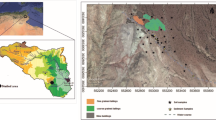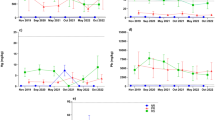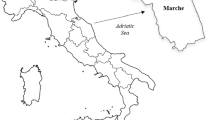Abstract
Purpose
San Luis Potosí is one of the largest metal producers; mining activity has been responsible for metal emissions for over 100 years, from several sources (deposits, tailings, effluents, and dusts) generating effects in human and ecosystem health. The objective of this study was to evaluate the effect of the concentrations of heavy metals in the soil health of four municipalities of San Luis Potosí contaminated with mine tailings, using enzyme activity as a biochemical endpoint.
Materials and methods
Four municipalities contaminated with residues of historical mining activity were analyzed (25 topsoil samples per type of site contaminated and reference). The parameters that were analyzed included pH; organic matter (OM); electrical conductivity (EC); percentage of clay, As, Cd, Cr, Cu, Hg, Pb, and Zn; and arylsulfatase (ARS), β-glucosidase (BG), urease (UR), and fluorescein diacetate hydrolysis (FDA) activities in soil. Differences among the parameters per municipality and type of site were evaluated using a factorial analysis of variance. The relationships were analyzed by Pearson’s correlation and a stepwise distance-based linear model permutation test (DistLM). Results were visualized using a distance-based redundancy analysis (dbRDA). A hazard quotient (HQ) for metals was calculated in order to estimate the effects on soil microbial processes.
Results and discussion
A concentration gradient (mg/kg) of Zn (4744.5–65,585.7), Pb (1321.0–31,932.2), As (ND-8736.7), and Cu (130.9–8475.4) was found in the contaminated sites. The HQ showed a very high hazard level for the elements detected in all contaminated sites (1.4–655.8). The pattern of enzymatic inhibition found was ARS (95.8 %), UR (90.6 %), FDA (86.9 %), and BG (76.0 %). Strong negative relationships were observed among enzymatic activities and heavy metals in the following inhibitory effect Cu > As > Zn > Pb. Metals and covariables explained from 84 to 86 % of variability in enzyme activity. EC, Cu, and As showed a strong inhibitory effect; and parameters such as OM, pH, and clay were found to have a slightly inducing effect.
Conclusions
In this study, the heavy metal concentrations were higher than the ones obtained in other reports for this region. The HQ reveals the presence of possible risks for the health of life in the region. The decrease of enzyme activities in soil could trigger adverse changes in the flow of matter and energy in ecosystems. This study provides a field baseline that could be part of a long-term monitoring program for these locations.



Similar content being viewed by others
References
Acosta-Martínez V, Tabatabai MA (2011) Sulfur cycle enzymes. In: Dick RP (ed) Methods of soil enzymology. Soil Science Society of America, Wisconsin, pp. 161–163
Adam G, Duncan H (2001) Development of a sensitive and rapid method for the measurement of total microbial activity using fluorescein diacetate (FDA) in a range of soil. Soil Biol Biochem 33:943–951
Adamo P, Zampella M, Gianfreda L, Renella G, Rutigliano FA, Terribile F (2006) Impact of the river overflowing on trace element contamination of volcanic soils in South Italy: part I trace element speciation in relation to soil properties. Environ Pollut 144:308–316
Allison SD, Vitousek PM (2005) Response of extracellular enzymes to simple and complex nutrient inputs. Soil Biol Biochem 37:937–944
Anderson MJ, Gorley RN, Clarke KR (2008) PERMANOVA + for PRIMER: guide to software and statistical methods. PRIMER-E, Plymouth, UK
Baath E, Frostergard A, Fritze H (1992) Soil bacterial biomass, activity, phospholipid fatty acid pattern, and pH tolerance in an area polluted with alkaline dust deposition. Appl Environ Microbiol 58:4026–4031
Bhattacharyya P, Tripathy S, Kim K, Kim SH (2008) Arsenic fraction and enzyme activities in arsenic contaminated soils by groundwater irrigation in West Bengal. Ecotox Environ Safe 71(1):149–156
Biró B, Domonkos M, Kiss E (2012) Catabolic FDA microbial activity as site-dependent monitoring tool in soil of an industrial town. Int Rev Sci Eng 3(1):41–46
Borowik A, Wyszkowska J, Kucharski J, Bacmaga M, Boros-Lajszner E, Tomkiel M (2014) Sensitivity of soil enzymes to excessive zinc concentrations. J Elem:637–648
Buchman MF (2008) NOAA Screening Quick Reference Tables (SQuiRTs) NOAA OR&R Report 08–1. Seattle WA Office of response and restoration division National Oceanic and Atmospheric Administration
Canadian Council of Ministers of the Environment CCME (2014) Soil Quality Guidelines for the Protection of Environmental and Human Health (SQG). Available from: http://www.ccme.ca/en/resources/canadian_environmental_quality_guidelines/index.html
Ciarkowska K, Gargiulo L, Mele G (2016) Natural restoration of soils on mine heaps with similar technogenic parent material: a case study of long-term soil evolution in Silesian-Krakow upland Poland. Geoderma 261:141–150
Combs SM, Nathan MV (2010) Soil organic matter. In: Brown JR (ed) Recommended chemical Soil Test Procedures of the North Central Region. Chapter 12. Missouri Agricultural Experiment station SB 1001, pp 53
D’Ascoli R, Rao MA, Adamo P, Renella G, Landi L, Rutigliano FA, Terribile F, Gianfreda L (2006) Impact of river overflowing trace element contamination of volcanic soils in South Italy: part II. Soil biological and biochemical properties in relation to trace element speciation. Environ Pollut 144:317–326
Deng S, Popova I (2011) Carbohydrate hydrolases. In: Dick RP (ed) Methods of soil enzymology. Soil Science Society of America, Wisconsin, pp. 185–198
Deng SP, Tabatabai MA (1997) Effect of tillage and residue management on enzyme activities in soils: III. Phosphatases and arylsulfatase. Biol Fertil Soils 24:141–146
Diario Oficial de la Federación DOF (2002) Norma Oficial Mexicana (NOM-021-SEMARNAT-2000) Que establece las especificaciones de fertilidad, salinidad y clasificación de suelos. Estudio, muestreo y análisis. [Official Mexican Standard, which fixed the fertility, salinity and soil classification. Study, sampling and analyses] Mexico. http://dof.gob.mx/nota_detalle.php?codigo=717582&fecha=31/12/2002. Retrieved October 20, 2015
Dick RP (1997) Soil enzyme activities as integrative indicators of soil health. In: Pankhurst CE, Doube BM, Gupta VVSR (eds) Biological indicators of soil health. CAB International, Wallingford, pp. 121–156
Doran JW, Parkin TB (1994) Defining and assessing soil quality. In: Doran JW, Coleman DC, Bezdicek DF, Stewart BA (eds) Defining soil quality for a sustainable environment. Soil Science Society of America, Madison, pp. 3–21
Effron D, de la Horra AM, Defrieri RL, Fontanive V, Palma PM (2004) Effect of cadmium, copper, and lead on different enzyme activities in a native forest soil. Comm Soil Sci Plant Anal 35:1309–1321
Eivazi F, Tabatabai MA (1988) Glucosidases and galactosidases in soils. Soil Biol Biochem 20:601–601. doi:10.1016/0038-0717(88)90141-1
Eivazi F, Tabatabai MA (1990) Factors affecting glucosidase and galactosidase activities in soils. Soil Biol Biochem 22:891–897
Espinosa-Reyes G, González-Mille DJ, Ilizaliturri-Hernández CA, Mejía-Saavedra J, Cilia-López G, Costilla-Salazar R, Díaz-Barriga F (2014) Effect of mining activities in biotic communities of villa de la Paz, San Luis Potosi, Mexico. Biomed Res Int. doi:10.1155/2014/165046
Friedlová M (2010) The influence of heavy metals on soil biological and chemical properties. Soil. Water Res 5(1):21–27
Gaspar ML, Cabello MN, Pollero R, Aon MA (2001) Fluorescein diacetate hydrolysis as a measure of fungal biomass in soil. Curr Microbio 42:339–344
Geiger G, Brandi H, Furner G, Schulin R (1998) The effect of copper on the activity of cellulose and β-glucosidase in the presence of montmorillonite or Al-montmorillonite. Soil Biol Biochem 30:1537–1544
Gomes NCM, Landu L, Smalla K, Nannipieri P, Brookes PC, Renella G (2010) Effects of Cd- and Zn-eriched sewage sludge on soil bacterial and fungal communities. Ecotoxicol Environ Safety 73:1255–1263
Haigh SD, Rennie AFK (1994) Rapid methods to assess the effects of chemicals on microbial activity in soil. Environ Toxic Water 9:347–354
Hemida SK, Omar SA, Abdel-Mallek AY (1997) Microbial populations and enzyme activity in soil treated with heavy metals. Water Air Soil Pollut 95:13–22
Hernández AJ, Beerril JM, Zárate O, Garbisu C (2006) Assessment of the efficiency of a metal phytoextraction process with biological indicators of soil health. Plant Soil 281:147–158
Jadwiga W, Miroslaw K, Jan K (2010) Activity of β-glucosidase, arylsulfatase and phosphatases in soil contaminated with cooper. J Elem 15(1):213–226
Jasso-Pineda Y, Espinosa-Reyes G, González-Mille D, Razo-Soto I, Carrizales L, Arturo Torres-Dosal A, Mejía-Saavedra J, Monroy M, Irina AI, Yarto M, Díaz-Barriga MF (2007) A n integrated health risk assessment approach to the study of mining sites contaminated with arsenic and lead. Interg Environ Assess Manag 3(3):344–350
Jones JJB (2001) Laboratory guide for conducting soil test and plant analysis, vol 28-31. CRC press, Washington DC, pp. 151–155
Kandeler E, Gerber H (1988) Short-term assay of soil urease activity using colorimetric determination of ammonium. Bio Fertil Soils 6:68–72. doi:10.1007/BF00257924
Kandeler E, Poll C, Frankenberger WT, Tabatabai MA (2011) Nitrogen cycle enzymes. In: Dick RP (ed) Methods of soil enzymology. Soil Science Society of America, Wisconsin, pp. 121–156
Karaca A, Cetin C, Turgay OC, Kizilkaya R (2010) Effects of heavy metals on soil enzyme activities. In: Sherameti I, Varma A (eds) Soil biology: soil heavy metals. Springer-Verlag Berlin Heidelberg, New York, pp. 239–245
Karlen DL, Andrews SS, Wienhold BJ (2004) Soil quality, fertility and health–historical context, status and perspectives. In: Schjønning P, Elmholt S, Christensen BT (eds) Managing soil quality: challenges in modern agriculture. CABI Publishing, Wallingford, pp. 17–33
Klose S, Bilen S, Tabatabai MA, Dick WA (2011) Sulfur cycle enzymes. In: Dick RP (ed) Methods of soil enzymology. Soil Science Society of America, Wisconsin, pp. 133–137
Kuperman RG, Carreiro MM (1997) Soil heavy metal concentrations, microbial biomass and enzyme activities in a contaminated grassland ecosystem. Soil Biol Biochem 29(2):179–190
Li YT, Rouland C, Benedetti M, Li FB, Pando A, Lavelle P, Dai J (2009) Microbial biomass, enzyme and mineralization activity in relation to soil organic C, N and P turnover influenced by acid metal stress. Soil Biol Biochem 41:969–977
Lorenz N, Hintemann T, Kramarewa T, Katayama A, Yasuta T, Marschner P, Kandeler E (2006) Response of microbial activity and microbial community composition, in soils to long-term arsenic and cadmium exposure. Soil Biol Biochem 38:1430–1437
Mergeay M (2000) Bacteria adapted to industrial biotopes: the metal resistant Ralstonia. In: Hengge-Aronis R, Storz G (eds) Bacterial stress responses. ASM Press, Washington, DC, USA, pp. 403–414
Metson AJ, Blakemore LC, Rhoades DA (1979) Methods for the determination of soil organic carbon review and application to New Zealand soils. New Zeal J Sci 22:205–228
Mikanova O (2006) Effects of heavy metals on some soil biological parameters. J Geochem Explor 88:220–223
Monroy M, Díaz-Barriga MF, Razo I, Carrizales L (2002) Evaluación de la contaminación por arsénico y metales pesados (Pb, Cu, Zn) y análisis de riesgo en salud en Villa de la Paz-Matehuala, S.L.P. Instituto de Metalurgia, Universidad Autónoma de San Luis Potosí, México
Nannipieri P, Giagnoni L, Renella G, Puglisi E, Ceccanti B, Masciandaron G, Fornasier F, Moscatelli MC, Marinari S (2012) Soil enzymology: classical and molecular approaches. Biol Fertil Soils 48:743–762
Razo I, Carrizales L, Castro J, Díaz-Barriga MF, Monroy M (2004a) Arsenic and heavy metal pollution of soil, water and sediments in a semi-arid mining area in México. Water Air Soil Poll 152:129–152
Razo I, Téllez J, Monroy M, Carrizales L, Díaz-Barriga F, Castro J (2004b) As and Pb bioaccesibility in polluted soils from a mining site under semiarid climate in Mexico. In: Proceedings Tailings and Mine Waste. CRC Press, pp 173–182
Renella G, Ortigoza ALR, Landi L, Nannipieri P (2003) Additive effects of copper and zinc on cadmium toxicity on phosphatase activities and ATP content of soil as estimated by the ecological dose (ED50). Soil Biol Biochem 35:1203–1210
Schnürer J, Rosswall T (1982) Fluorescein diacetate hydrolysis as a measure of total microbial activity in soil and litter. Appl Environ Microbiol 43:1256–1261
Servicio Geológico Mexicano SGM (2007) Anuario estadístico de la Minería Mexicana ampliada. Servicio Geológico Mexicano y Secretaría de Economía. http://www.economia.gob.mx/files/comunidad_negocios/industria_comercio/informacionSectorial/minero/anuario_mineria_mexicana_2012_ed2013.pdf. Retrieved October 10, 2015
Sherene T (2010) Mobility and transport of heavy metals in polluted soil environment. BFAIJ 2(2):112–121
Speir TW, Kettles HA, Parshotam A, Searle PL, Vlaar LNC (1999) Simple kinetic approach to determine the toxicity of as [V] to soil biological properties. Soil Biol Biochem 31:705–713
Sutter GW II (2007) Ecological risk assessment, 2 edn. CRC Press, Florida
Tabatabai MA, Bremner JM (1970) Arylsulfatase activity of soils. Soil Sci Soc Am Proc 34:225-229. doi:10.2136/sssaj1970.03615995003400020016x
Vazquez-Vazquez SE (2012) Caracterizacion de un depósito no controlado de residuos mineros y evaluacion de su impacto en suelo superficial. Tesis de Maestría. Posgrado Multidisciplinario de Posgrado en Ciencias Ambientales. pp 118
Vogel-Mikuš K, Kump P, Nečemer M, Pelicon P, Arčon I, Pongrac P, Povh B, Regvar M (2010) Quantitative analyses of trace elements in environmental samples: options and (Im) possibilities. In: Sherameti I, Varma A (eds) Soil biology: soil heavy metals. Springer-Verlag Berlin Heidelberg, New York, pp. 114–122
Wyszkowska J, Kucharski J, Lajszner W (2006) The effects of copper on soil biochemical properties and its interaction with other heavy metals. Pol J Environ Stud 15(6):927–934
Yáñez L, García-Nieto E, Rojas E, Carrizales L, Mejía J, Calderón J, Razo I, Díaz-Barriga MF (2003) DNA damage in blood cells from children exposed to arsenic and lead in a mining area. Environ Res 93:231–240
Yang Z, Liu S, Zheng D, Feng S (2006) Effects of cadmium, zinc, and lead on soil enzyme activities. J Environ Sci 18:1135–1141
Yang G, Pei Z, Liang M, Yue-Er Z, Wan-Yun S (2009) Assessment of effects of heavy metals combined pollution soil enzyme activities and microbial community structure: modified ecological dose–response model and PCR-RAPD. Environ Earth Sci 60:603–612
Zahran HH (1997) Diversity, adaptation and activity of the bacterial flora in saline environments. Biol Feril Soils 25:211–223
Zhang MK, Wang LP (2007) Impact of heavy metals pollution on soil organic matter accumulation. Ying Yong Sheng Tai Xue Bao 18(7):1479–1483
Acknowledgments
This work was supported by a grant from the Consejo Nacional de Ciencia y Tecnología (CB-178778) and Universidad Autónoma de San Luis Potosí (C12-FAI-03-67.67). Special thanks to Miss Laura Carmen Martínez Turrubiartes for English language editing of the manuscript and PhD. Edlin Guerra Castro for the multivariate analysis advice. None of the authors has any conflicts of interest to declare.
Author information
Authors and Affiliations
Corresponding author
Additional information
Responsible editor: Chengrong Chen
Rights and permissions
About this article
Cite this article
Martínez-Toledo, Á., Montes-Rocha, A., González-Mille, D.J. et al. Evaluation of enzyme activities in long-term polluted soils with mine tailing deposits of San Luis Potosí, México. J Soils Sediments 17, 364–375 (2017). https://doi.org/10.1007/s11368-016-1529-8
Received:
Accepted:
Published:
Issue Date:
DOI: https://doi.org/10.1007/s11368-016-1529-8




